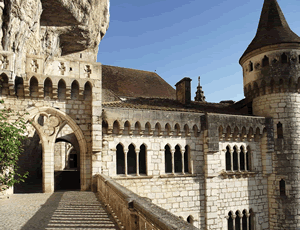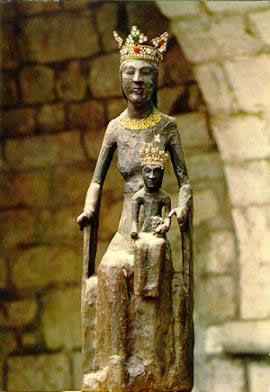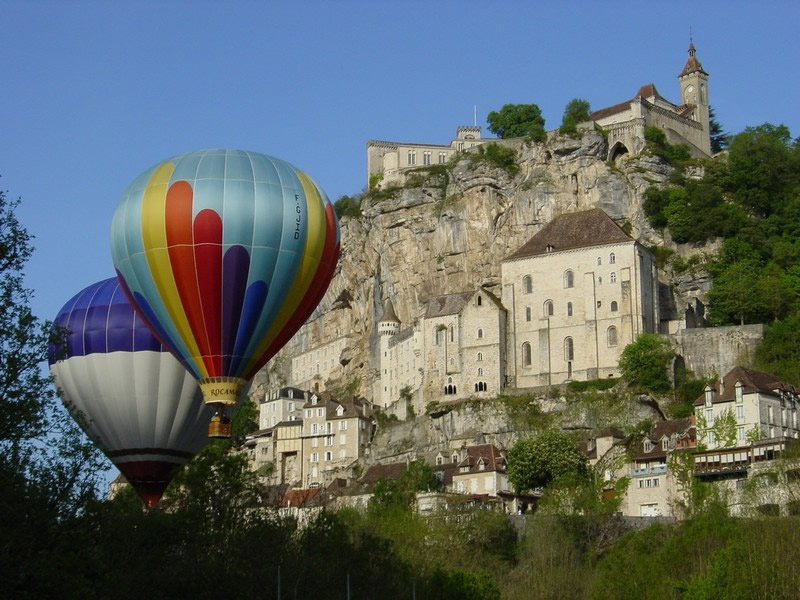
History
(with
acknowledgment to Wikipedia)
Rocamadour has attracted visitors for its setting in a gorge above
a tributary of the River Dordogne, and especially for its historical
monuments and its sanctuary of the Blessed Virgin Mary, which for centuries
has attracted pilgrims from every country, among them kings, bishops,
and nobles. The chief of them is the pilgrimage church of Notre
Dame (rebuilt in its present configuration from 1479), containing the
cult image at the center of the site's draw, a wooden Black Madonna reputed
to have been carved by Saint Amator (Amadour) himself.
According to the founding legend, Rocamadour is named after the founder
of the ancient sanctuary, Saint Amator, identified with the Biblical
Zacheus, the tax collector of Jericho mentioned in Luke 19:1-10, and
the husband of St. Veronica, who wiped Jesus' face on the way to Calvary.
Driven out of Palestine by persecution, St. Amadour and Veronica embarked
in a frail skiff and, guided by an angel, landed on the coast of Aquitaine,
where they met Bishop St. Martial, another disciple of Christ who was
preaching the Gospel in the south-west of Gaul. After journeying to Rome,
where he witnessed the martyrdoms of St. Peter and St. Paul, Amadour,
having returned to France, on the death of his spouse, withdrew to a
wild spot in Quercy where he built a chapel in honour of the Blessed
Virgin, near which he died a little later.

This
account, like most other similar legends, does not make its first appearance
till long after the age in which the chief actors are deemed to have
lived. The name of Amadour occurs in no document previous to the compilation
of his Acts, which on careful examination and on an application of
the rules of the cursus to the text cannot be judged older than the
12th
century. It is now well established that Saint Martial, Amadour's contemporary
in the legend, lived in the 3rd not the 1st century, and Rome has never
included him among the members of the Apostolic College. The mention,
therefore, of St. Martial in the Acts of St. Amadour would alone suffice,
even if other proof were wanting, to prove them doubtful.
The untrustworthiness
of the legend has led some recent authors to suggest that Amadour was
an unknown hermit or possibly St. Amator, Bishop of Auxerre, but this
is mere hypothesis, without any historical basis. The origin of the
sanctuary of Rocamadour, lost in antiquity, is thus set down along
with fabulous
traditions which cannot bear up to sound criticism. After the religious
manifestations of the Middle Ages, Rocamadour, as a result of war and
the French Revolution, had become almost deserted.
In the mid-nineteenth
century, owing to the zeal and activity of the bishops of Cahors, it
seems to have revived, and pilgrims and tourists are beginning to crowd
there again.
Among the many recorded
pilgrims to Rocamadour are Eleanor of Aquitane, Henry II of England, Louis
IX and Louis XI of France and Charles IV of France.
Main Rocamadour tourist site - click here |
To
check availability or make a reservation 
St Cere, Bed and
Breakfast, Evening Dinner. Delicious Vegetarian Meals also available. Fully
inclusive self-led walking holidays. House hunting.
Chambres and Table D'Hotes, Lot department, France.
Places to visit: St. Céré, Autoire, Loubressac, Cardaillac,
Bretenoux, Turenne, Beaulieu
sur Dordogne, Carennac, Curemonte, Salers, Martel,
Floirac, Castelnau, Rocamadour,
Lac du Tolerme, Argentat, Figeac, Cahors, St
Cirq Lapopie, Marcilhac, Cajarc, Collonges, Conques, Padirac, Pech
Merle, Gourdon,
Gramat, Capdenac, Rodez,
Gourdon, Souillac, Brive, Sarlat,
Domme, River Dordogne, River Lot, River Cele, River Cere, Lot
Quercy.
Things to do: Hiking, Cycling, Canoeing, Horse riding, Golf, Tennis, Swimming,
Bird Watching.
All in the local area of the delightful Lot department and the adjacent Correze,
Cantal, Aveyron and Dordogne departments of France
CLICK ON THE LINK BUTTONS AT THE TOP FOR MORE INFORMATION
FOR
MORE INFORMATION ABOUT OUR WALKING HOLIDAYS TAKE A LOOK AT OUR
OTHER WEBSITE WWW.WALKING-HOLIDAY-FRANCE.CO.UK
Home/Bedrooms
and Meals/Explore the Area/Walking
Holidays/Prices and Contact/Location
and Travel
House
for sale House
for sale
|


 Rocamadour
is the second most visited site in France outside of Paris so we have
devoted a page to this fascinating place. Some guide books will tell you
that Rocamadour is very touristy and we have to say that during August
it is hard to move with all the visitors. However, go outside the main
season and you will find a most dramatic and wonderful village that just
has to be seen. We can give you a few tips to see the village from the
best viewpoints and avoid the crowds.
Rocamadour
is the second most visited site in France outside of Paris so we have
devoted a page to this fascinating place. Some guide books will tell you
that Rocamadour is very touristy and we have to say that during August
it is hard to move with all the visitors. However, go outside the main
season and you will find a most dramatic and wonderful village that just
has to be seen. We can give you a few tips to see the village from the
best viewpoints and avoid the crowds.
